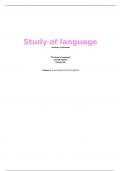Summary
Study of language/ linguistics summary
- Course
- Institution
- Book
This document is a summary of the book “study of language” by George Yule seventh ed. All components are listed under headings for a clear overview. The chapters that come back here are: 1,5,6,9,10,11,12,15,17,18,19
[Show more]




